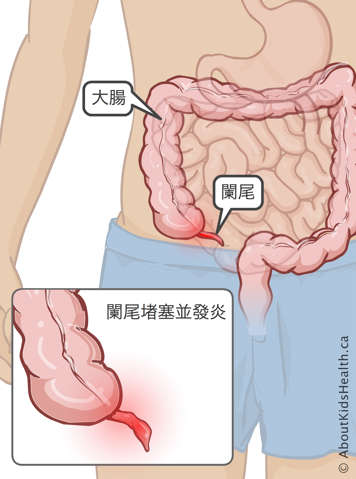
什麽是闌尾炎?
闌尾炎是指闌尾感染或腫脹。闌尾是連在大腸前端的小的管狀結構,被稱爲結腸。位于孩子腹部(肚臍)右下方。據知,闌尾在人體上沒有用途。
當闌尾開始阻滯時就會産生闌尾炎,阻滯導致闌尾腫脹,腫脹會導致疼痛、腹瀉、噁心(嘔吐)和發熱等症狀。
如果醫生認爲你的孩子有患闌尾炎的可能,那麽就要對其進行檢查,或許也要讓其進行超聲波或計算層析式X 射綫 (CT) 掃描。
什麽是闌尾切除術?
如果你的孩子患闌尾炎,通常就表示孩子需要通過外科手術將闌尾切除。這項手術叫做闌尾切除術(發音爲:a-pen-DECK-ta-mee)。這是一項常見的簡單手術,正常情况下這項手術不會影響孩子的成長,孩子依然能够消化食物。
這項手術要麽是急診手術要麽是計劃內手術,具體取决于孩子的病情。孩子的醫生將决定孩子手術前就需要住院還是手術當天再來醫院。
闌尾切除術期間
孩子將被注射叫做全身麻醉的特殊"催眠藥物"。這會讓你的孩子在手術中處于睡眠狀態而無任何疼痛感。
醫生會在孩子的腹部切口。醫生會使用一種叫做腹腔內窺鏡的照相機幷切出很小的切口,將孩子的闌尾切除,然後將連接的腸道縫合。接下來醫生會使用一種叫做免縫膠帶的小塊膠帶將切口縫合。
一次闌尾切除術要花 1 個小時左右。
闌尾切除術之後
闌尾切除術之後,要將孩子送進麻醉護理部(也叫 PACU 或康復室)。孩子需要在那裏待 1 個小時左右,當孩子術後醒來時你可以去看他。之後孩子將會被送回住院部,孩子需要在那裏待 12 - 24 個小時左右。
當孩子有以下表現就可以出院了:
- 心率、呼吸、血壓和體溫一切正常
- 能够吃東西而不會噁心(嘔吐)
- 能够服用口服止痛藥(口服藥是通過嘴巴服用的藥物)
在家照顧孩子
切口護理
用免縫膠帶將手術中的切口縫合,你不需要動這些膠帶。在觸碰或清洗切口部位前要將雙手洗淨。
膠帶上有少量的血是正常現象。但是如果膠帶上的血看起來像鮮血或血有所增加,則用乾淨毛巾按壓該部位 5 - 6 分鐘。然後打電話到孩子的醫生辦公室詢問。
如果依然流血不止,請帶孩子找家庭醫生或將其送到急診室。
免縫膠帶會自行脫落,如果孩子手術後 7 - 10 天沒有自行脫落,你可以自己動手將這些膠帶拆下來。
活動
當孩子覺得自己可以進行正常活動時,他就可以進行正常活動了。
飲食
手術後孩子應能够回歸以往的飲食習慣,如果孩子存在飲食困難,請致電孩子的醫生辦公室。
止痛藥
當孩子出院時,你要在孩子手術後的 24 小時之內給其服用醋胺酚。根據藥瓶上的說明給孩子服藥。在手術後的 24 小時之後可以根據需要給孩子服用止痛藥。
洗浴
手術後 48 小時,可以給孩子洗澡。
學校
當孩子覺得一切正常,而你也覺得孩子已經恢復到以前的日常習慣時,孩子就可以回托兒所或學校了。
何時聯繫外科醫生小組
闌尾切除術後主要的擔憂就是喉癰(感染)。一旦你發現孩子出現以下任一種迹象或感染症狀,請致電孩子主治醫生的辦公室進行咨詢:
- 發燒達 38.5℃ (101℉) 或更高
- 切口處有發黃或綠且惡臭的分泌物
- 切口部位流血
- 切口部位發紅
- 切口部位腫脹
- 疼痛加重,甚至服用過止痛藥之後
- 沒什麽胃口或噁心(嘔吐)
- 胃痛或胃脹(腫脹或發脹)
- 孩子處于昏睡狀態或非常疲憊和嗜睡
如果你有疑問或擔憂,但是不很緊急,則可以在正常工作時間致電孩子醫生的辦公室或在答復機上給其留言。如果有緊急情况,請將孩子帶去找孩子的家庭醫生、兒科醫生或將其送到最近的急診室。
孩子的外科醫生姓名:
電話號碼:
孩子的私人醫生姓名:
電話號碼:
要點
- 如果你的孩子患闌尾炎,那麽孩子需要通過外科手術將闌尾切除。
- 闌尾切除術是急診手術還是計劃內手術,這取决于孩子的病情。
- 需要對孩子全身麻醉進行手術。
- 如果孩子流血過多或有感染迹象,請立即聯繫孩子醫生辦公室。